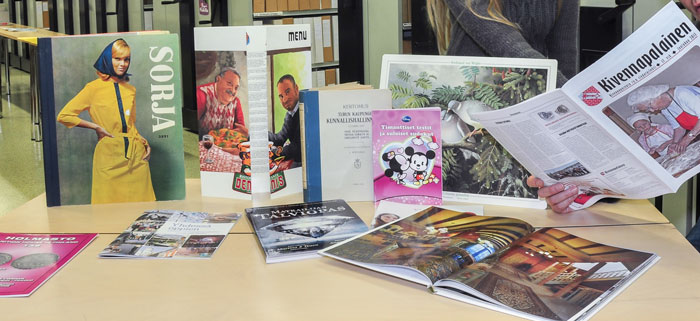Newspapers and ephemera – how does the library benefit the history researcher?
In Raisio are located the newspaper and ephemera services of the Turku University Library. Their importance for research and teaching is described by Tiina Lintunen, a university teacher of Political History.

You are known for your research on the Finnish Civil War.
”In my research I have focused on women involved in the Finnish Civil war and their life after the war. The research has looked at their role in the war, how they were perceived at the end of the war and the course of their lives later at the time of the Finnish nationalistic Lapua Movement and after the wars of the 1940s.”
You have had to collect archival material from several decades?
”Indeed, this has required going through a great number of archival collections. At the Turku University Library, the Raisio newspaper collection has been an important aid. It really helps to carry out research when you can find both labour and bourgeois newspapers over a longer time period in one place without having to gather them from multiple places. Due to this, for example, it was easy to search various newspapers for job announcements of female servants and see how they specifically deterred Red women from applying. For historians, newspapers provide an important window to the past.”
So the Raisio services have been satisfactory?
”Although a bit far away, Raisio offers great premises for such a large newspaper collection. Customer service, especially, is always excellent and the staff is happy to advise you and help with your searches. I recall how the personnel once kindly collected me information on all available political materials.”
In addition to newspapers, have you also used the ephemera materials in Raisio?
”For a couple of years I have taken my students to visit the ephemera collection which has proven to be a real treasury for thesis workers. From the collection it is easy to find Finnish research materials dealing with elections, Nordic co-operation, the 1970s energy policy or court-martial, among other things.”
So ephemera are valuable for teaching and studying political history?
”There are plenty of Finnish materials relevant also for students in other fields. Among the collection items you can find, for example, a collection of Sami ways and traditions, population policy and folklore–related materials as well as various art, law and teaching-related collections.
I could imagine that ephemera texts would provide very interesting material, for example, for discourse analyses in Finnish and Swedish language studies. For art researchers, the poster collection in Raisio is absolute must! All in all, I would recommend all thesis work instructors especially in humanities to introduce their students to this primary source collection.”
So in your opinion it is valuable that the Turku University Library provides access to these kinds of printed primary materials?
”For research it is vital that primary resources and research literature are tangible. Compared with printed newspapers, the microfilmed and digitized resources are not as user friendly. Although you can browse the digital versions of newspapers from your home couch, studying digitally large text collections is always harder. The printed materials are also needed in future!

Facts:
The Turku University Library has received all Finnish newspapers as free deposits between the years 1919-2007. The collection offers access to small local papers as well as bigger daily newspapers. In addition there are newspapers published outside of Finland, e.g. in the USA, Canada, Soviet Karelia and Sweden.
The Finnish ephemera collection at the Turku University Library is unique because it is the largest collection of small prints in Finland after Helsinki. Ephemera are every day prints offering a versatile snapshot of the entire society, including e.g. pricelists, annual reports, adverts and posters.
Although the law on free deposits goes back to 1919 in Turku, the newspaper and ephemera collections include also earlier materials received as gifts.
Interview: Ilmari Jauhiainen
Facts: Sara Kannisto
Translation: Kristiina Hintikka
Photos: Krista Voitto and Teppo Kahtola